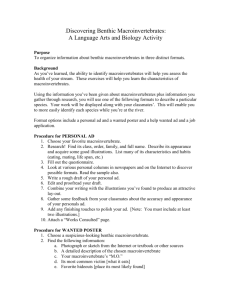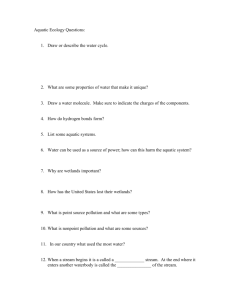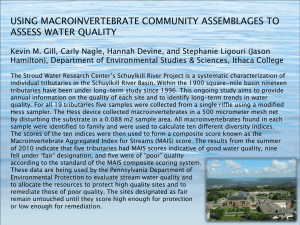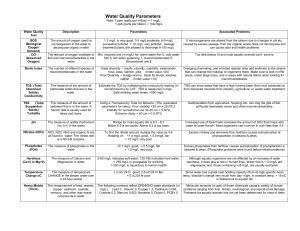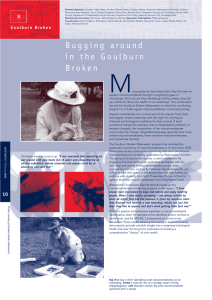Macroinvertebrates Lesson Plan
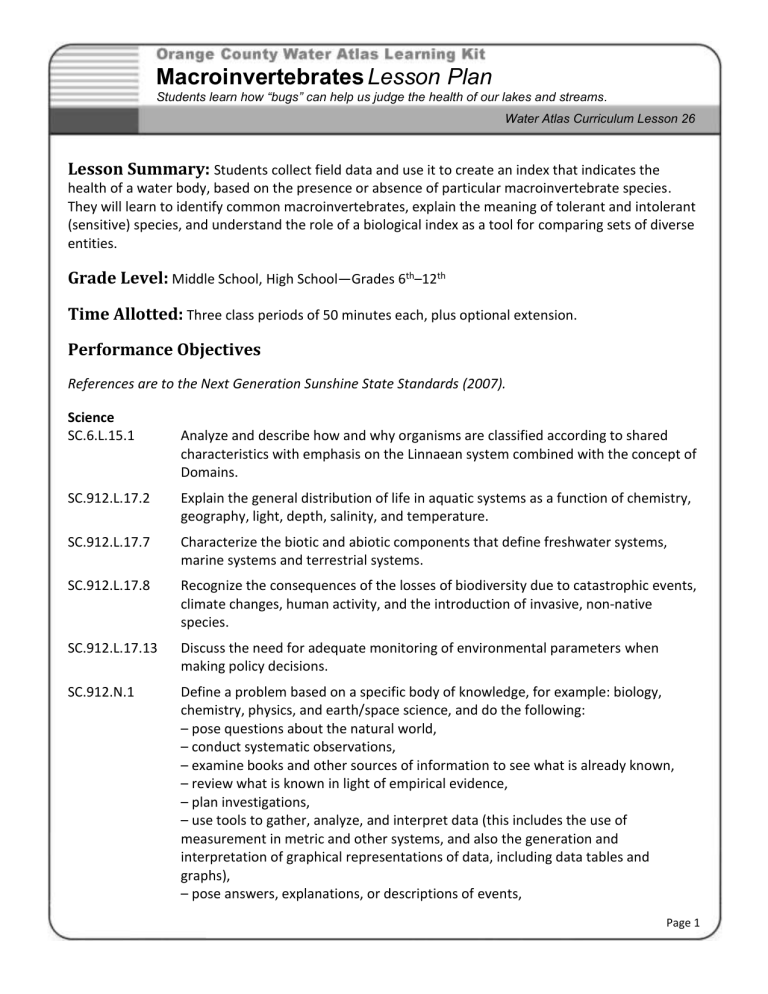
Macroinvertebrates Lesson Plan
Students learn how “bugs” can help us judge the health of our lakes and streams.
Water Atlas Curriculum Lesson 26
Lesson Summary:
Students collect field data and use it to create an index that indicates the health of a water body, based on the presence or absence of particular macroinvertebrate species.
They will learn to identify common macroinvertebrates, explain the meaning of tolerant and intolerant
(sensitive) species, and understand the role of a biological index as a tool for comparing sets of diverse entities.
Grade Level:
Middle School, High School—Grades 6 th –12 th
Time Allotted:
Three class periods of 50 minutes each, plus optional extension.
Performance Objectives
References are to the Next Generation Sunshine State Standards (2007).
Science
SC.6.L.15.1 Analyze and describe how and why organisms are classified according to shared characteristics with emphasis on the Linnaean system combined with the concept of
Domains.
SC.912.L.17.2 Explain the general distribution of life in aquatic systems as a function of chemistry, geography, light, depth, salinity, and temperature.
SC.912.L.17.7 Characterize the biotic and abiotic components that define freshwater systems, marine systems and terrestrial systems.
SC.912.L.17.8 Recognize the consequences of the losses of biodiversity due to catastrophic events, climate changes, human activity, and the introduction of invasive, non-native species.
SC.912.L.17.13 Discuss the need for adequate monitoring of environmental parameters when making policy decisions.
SC.912.N.1 Define a problem based on a specific body of knowledge, for example: biology, chemistry, physics, and earth/space science, and do the following:
– pose questions about the natural world,
– conduct systematic observations,
– examine books and other sources of information to see what is already known,
– review what is known in light of empirical evidence,
– plan investigations,
– use tools to gather, analyze, and interpret data (this includes the use of measurement in metric and other systems, and also the generation and interpretation of graphical representations of data, including data tables and graphs),
– pose answers, explanations, or descriptions of events,
Page 1
Macroinvertebrates Lesson Plan
Students learn how “bugs” can help us judge the health of our lakes and streams.
Water Atlas Curriculum Lesson 26
– generate explanations that explicate or describe natural phenomena (inferences),
– use appropriate evidence and reasoning to justify these explanations to others,
– communicate results of scientific investigations, and
– evaluate the merits of the explanations produced by others.
Language Arts
LA.6.1.6
LA.8.2.2.3
LA.8.2.2.4
LA.910.5.2.2
The student uses multiple strategies to develop grade appropriate vocabulary.
The student will organize information to show understanding or relationships among facts, ideas, and events (e.g., representing key points within text through charting, mapping, paraphrasing, summarizing, or comparing/contrasting).
The student will identify and analyze the characteristics of a variety of types of text
(e.g., reference works, reports, technical manuals, newspapers, magazines, biographies, periodicals, procedures, instructions, practical/functional texts).
The student will research and organize information for oral communication appropriate for the occasion, audience, and purpose (e.g., digital presentations, charts, photos, primary sources, webcasts).
Math
MA.6.A.1.3
MA.8.S.3.1
MA.7.S.6.1
Solve real-world problems involving multiplication and division of fractions and decimals.
Select, organize and construct appropriate data displays, including box and whisker plots, scatter plots, and lines of best fit to convey information and make conjectures about possible relationships.
Evaluate the reasonableness of a sample to determine the appropriateness of generalizations made about the population.
Social Studies
SS.912.G.5.6 Analyze case studies to predict how a change to an environmental factor can affect an ecosystem.
Prior Knowledge
Students should have some knowledge about the Linnean system for the scientific classification of organisms.
Topic Overview
The term macroinvertebrates includes all the insects (six legs, adults with 2 pair of wings and antennae) along with other invertebrates (animals without backbones such as clams, snails, flatworms) and arthropods (jointed-legged animals like mites, crustaceans, isopods and amphipods). They are
Page 2
Macroinvertebrates Lesson Plan
Students learn how “bugs” can help us judge the health of our lakes and streams.
Water Atlas Curriculum Lesson 26 large enough to be seen without the aid of a dissecting scope or hand lens (though these tools are useful in seeing details used in identification). Macroinvertebrate orders include:
Ephemeroptera (Mayfly) Diptera (True Flies)
Plecoptera (Stonefly)
Trichoptera (Caddisfly)
Odonata (Dragonfly & Damselfly)
Pelecypoda (Clams)
Megaloptera (Dobsonfly / Hellgrammite)
Coleoptera (Aquatic Beetles)
Gastropoda (Snails)
Hemiptera (True Bugs)
Macroinvertebrates are routinely used as biological indicators of water quality and overall lake and stream health because they vary significantly in their tolerance for water pollution, particularly turbidity and dissolved oxygen level. For example, mayflies, stoneflies and most types of caddisflies require relatively cool, clear, well-oxygenated water and are sensitive to environmental changes brought on by water pollution. Dragonfly nymphs and crayfish are considered “moderately tolerant” or
“somewhat sensitive,” whereas leeches, aquatic worms and most true flies (i.e. black flies and midges) are very able to tolerate warmer, more turbid conditions. Considered as a whole, the ratio of tolerant to intolerant (sensitive) organisms can indicate the overall water quality of a resource. Water scientists also consider the number of different species present in a water body as a measure of its biodiversity, and therefore, its biotic health.
Unlike fish, macroinvertebrates can’t escape sudden changes in the aquatic environment, such as an influx of pollution, by swimming away. Since their life cycles are relatively short, changes in their populations can be noted relatively quickly. Regulatory agencies, researchers and volunteer water quality monitors use a variety of mathematical formulas that incorporate different species of macroinvertebrates to provide an overall water quality score, or index.
In addition to being classified as either tolerant or sensitive, macroinvertebrates also may be categorized into major functional feeding groups, such as:
Scrapers/grazers, which consume algae and associated material;
Shredders, which consume leaf litter or other coarse particulate organic matter (CPOM), including wood;
Collector-gatherers, which collect fine particulate organic matter (FPOM) from the stream bottom;
Collectors-filterers, which collect FPOM from the water column using a variety of filters;
Predators, which feed on other consumers, and
“Other,” which includes species that are omnivores, or that simply do not fit neatly into the other categories.
Yet another way to group macroinvertebrates is by their habitat and behavior—the “functionality” of the organism (e.g., the way it moves or searches for food). Habitat designations include:
Clinger – able to remain stationary on bottom substrates in flowing waters
Climber – feeds in submerged aquatic vegetation (SAV) by climbing
Page 3
Macroinvertebrates Lesson Plan
Students learn how “bugs” can help us judge the health of our lakes and streams.
Water Atlas Curriculum Lesson 26
Sprawler – can be found on both the surface of SAV and substrates
Burrower – feeds on FPOM while buried in sediments of lakes and streams
Swimmer – can control the direction and velocity of their movements
Diver – able to swim from the surface to the bottom of the water column
Biotic indices which use macroinvertebrate population data are common components of biological water quality assessment studies, and dozens have been developed for specific uses or regions. Those that are most commonly employed in assessing the health of Florida lakes and streams are listed in the vocabulary. Biological data is collected by Orange County EPD to assess the status of water quality in the county. In addition to macroinvertebrate sampling, lake vegetation surveys (LVI) have recently been introduced as additional alternative criteria for assessing the quality of our water.
Macroinvertebrate and LVI data collected by the Orange County Environmental Protection Division is presented on the Orange County Water Atlas for a number of different lakes.
Key Vocabulary
Abundance
The degree to which individuals of a certain species are present.
Benthic
Bottom-dwelling.
Bioassessment
Biological assessments evaluate the condition or “health” of a water body using direct measurements of biological indicators in surface waters and integrate the cumulative impacts of chemical, physical, and biological stressors on aquatic life.
Bioindicator
An organism used as a marker of the quality of an ecosystem, especially with respect to pollution.
Biotic index
A “score” used to indicate the relative health of a water body, judged by the amount and type of aquatic life that dwells in it.
Diversity
The variety and abundance of different types of organisms which inhabit an area.
Dissolved oxygen
The oxygen freely available in water that is vital to the existence of fish and other aquatic life. It is considered the single most important indicator of a water body's ability to support desirable aquatic life.
EPT Index
EPT is an acronym for Ephemeroptera (mayflies), Plecoptera (stoneflies), and Trichoptera
Page 4
Macroinvertebrates Lesson Plan
Students learn how “bugs” can help us judge the health of our lakes and streams.
Water Atlas Curriculum Lesson 26
(caddisflies), three orders of insects that are very sensitive to pollution. If a lake or stream has a high number of insects from these taxa, then its water quality is probably very good.
Habitat assessment
An evaluation of the structure of the surrounding habitat that influences the quality of the water resource and the condition of the aquatic community.
Lake Condition Index (LCI)
This index is calculated by combining eight benthic macroinvertebrate measures which appear to be responsive to lake stressors (e.g., urban runoff, agricultural drainage, contamination).
Lake Vegetation Index (LVI)
This index determines how closely the lake’s flora resembles that of an undisturbed lake. The
LVI method involves dividing a lake into 12 units and identifying plants in 4 of the 12 units.
Macroinvertebrate
An animal without a backbone that is large enough to be seen with the naked eye.
Sensitive
“Sensitive” taxa are unable to tolerate pollution in their environment. Thus, their presence indicates good water quality. Another term for them is “intolerant” taxa.
Shannon Weaver Diversity Index
A calculated index that indicates the amount of order (or disorder) observed within a particular system. The index has its origins in information theory and in ecological studies is used as a measure of species richness, taking into account the total number of species and the relative proportion of each within the local aquatic community.
Stream Condition Index (SCI)
The SCI is a composite macroinvertebrate index for use in flowing streams. Sampling consists of
20 dipnet sweeps of the most productive habitats found in a 100-meter stretch of a stream.
Taxon
A group (family, genus, or species, e.g.) to which living things are assigned by biologists, within the system that scientists use to classify organisms. Plural: taxa.
Tolerant
“Tolerant” taxa are those that are able to survive in a relatively broad range of environmental conditions; i.e., they are more tolerant of pollution.
Turbidity
The measurement of how much light penetrates a water body; haziness or cloudiness caused by suspended organic or inorganic particles or silt.
Materials
Diagram of macroinvertebrate parts, taxonomic keys
Page 5
Macroinvertebrates Lesson Plan
Students learn how “bugs” can help us judge the health of our lakes and streams.
Water Atlas Curriculum Lesson 26
Dipnet (D-net)
Magnifying lenses
Buckets
Trays or dishpans (white ones make the “bugs” easier to see)
Latex gloves
Tweezers
Eye droppers and/or basting syringes
Digital camera
Large buckets or jars for water samples (if using previously-collected samples in lieu of site visit)
Fish tank aerator (optional, to aerate collected water samples while in the classroom)
Small (aquarium-size) dipnet (optional, if using previously-collected water samples)
References
The following documents are available in the Orange County Water Atlas Digital Library:
A Beginner’s Guide to Water Management: Oxygen and Temperature . 2004. Florida LAKEWATCH,
University of Florida Institute of Food and Agricultural Sciences.
Denson, Dana R. 2007. Changes in the Macroinvertebrate Community of a Central Florida Wetland .
Florida Department of Environmental Protection.
FT3000 Aquatic Habitat Characterization (Field data sheets and instructions). 2008. Florida Department of Environmental Protection.
Long-lived Macroinvertebrate Taxa . 2007. Florida Department of Environmental Protection.
Macroinvertebrates as Indicators of Stream Health . 2007. Michigan Clean Water Corps.
Macroinvertebrate Identification Chart . 2010. Florida Department of Environmental Protection.
Minnesota Department of Natural Resources. 2007. Macroinvertebrate key .
Sampling and Use of the Stream Condition Index (SCI) for Assessing Flowing Waters: A Primer . 2007.
Florida Department of Environmental Protection.
Sensitive Macroinvertebrate Taxa . 2004. Florida Department of Environmental Protection.
Other References:
Bureau of Laboratories List of Keys and Guides (webpage accessed July 2011). Florida Department of
Environmental Protection. (This page has links to keys for the identification of various kinds of organisms.)
Invertebrates as Indicators (webpage). U.S. Environmental Protection Agency. Accessed July 2011.
Merritt, R. W. and K. W. Cummins, and Berg, M.B., eds., 2008. An Introduction to the Aquatic Insects of North
America (4 th ed.,). Kendall/Hunt Publishing Co., Dubuque, Iowa. 1214 pp. ISBN 978-0-7575-6321-8.
Page 6
Macroinvertebrates Lesson Plan
Students learn how “bugs” can help us judge the health of our lakes and streams.
Water Atlas Curriculum Lesson 26
Procedure
Engage/Elicit
1.
Ask the students if they can tell how healthy the water body is by looking at it. How can they find out? They can test various parameters of the water through chemical/physical tests, but can also perform a biological assessment by seeing what organisms are present. Review the following terms: macroinvertebrate (including life cycle and seasonal differences), bioindicator, tolerant, intolerant, taxa, diversity (richness) vs. abundance.
2.
Review with students where macroinvertebrates might be found. Do you think there will be many bugs swimming in the water column like fish? Most will be in the mud or attached to emergent or floating vegetation. Though they are invertebrates that can be seen with the naked eye, students will have to look very closely to find them. Review with students the different ways in which macroinvertebrates can be grouped (see Topic Summary).
3.
Ask students to propose a hypothesis related to the macroinvertebrates and how healthy the lake/stream site is that they will find at your sample site, and record it on their data sheets.
Explore
1.
If you are having students collect macroinvertebrates on-site, demonstrate for them the proper technique for using the dip net. Have students take turns dip-netting to find macroinvertebrates along the lake edge or river bank, while others identify them and record data.
2.
If you are unable to take students to a lake or stream site, you may collect macroinvertebrates for them to sort and identify, no earlier than 24 hours before class time. Store the collected samples in a wide-mouthed jug containing water from the habitat; keep the jug in a cool, insulated ice chest to slow the respiration rate of the organisms, or use an aquarium pump to provide aeration. To collect the samples, perform sweeps with a D-frame dipnet from the site’s four most productive habitat areas and transfer the material in the net to the jug, performing a cursory examination of the diversity of organisms collected. If fewer than four productive habitats are available, select a particularly productive habitat sampled in an earlier sweep and repeat until four sweeps have been completed. At class time, dole out portions of the water into dishpans and give one to each group of students for sorting and identification. Have the students in each group take turns identifying macroinvertebrates and recording data.
Explain
1.
Once students have identified the macroinvertebrates, have them use the checklist of Sensitive
Macroinvertebrate Taxa (listed under Resources) to tally their macroinvertebrates on the
Student Data Sheets. They should then calculate the index value and determine the water quality assessment.
2.
Have the students review their results. What do they mean? In particular:
Would finding mostly tolerant (or somewhat tolerant) species mean that water quality is always poor?
Page 7
Macroinvertebrates Lesson Plan
Students learn how “bugs” can help us judge the health of our lakes and streams.
Water Atlas Curriculum Lesson 26
What could you say about the water quality if you found a mayfly?
How could seasons/time of year influence which species you might find?
How would you improve your sampling to get a more representative index?
Extension Options
Extension 1: Overall habitat quality is determined by measuring eight attributes known to have potential effects on the stream biota. Florida Department of Environmental Protection (FDEP) protocols use a bioassessment method which involves performing a mapping exercise and conducting a series of observations. Using all the information collected, each of eight habitat parameters on is then given a score ranging from 1 to 20, with 20 being the highest quality.
Have students visit a stream in Orange County and use the FDEP’s Field Habitat Assessment Form to do a habitat assessment of the site.
Extension 2: Ask students to think about what effect, if any, climate change might have on the types and numbers of macroinvertebrates found in lakes and streams. You may wish to remind them that as water becomes warmer, the amount of oxygen it can hold decreases.
Examples of questions students might consider:
Would all species be equally affected, or might there be “tolerant” and “sensitive” species in regard to water temperature?
Would bottom-dwelling (or surface-dwelling) species be more or less sensitive to temperature changes, as a group?
Would macroinvertebrate biodiversity increase or decrease in a warmer environment?
How would increased rainfall (and thus water flow and sedimentation) impact the macroinvertebrate community?
Have students propose a hypothesis related to temperature and macroinvertebrates, and then design an experiment that could test it. They do not actually have to perform the experiment, but they should be able to explain how their experimental procedure would prove or disprove their hypothesis.
Exchange/Evaluate
1.
Have students write stories that describe their site visit to collect macroinvertebrates, explaining the purpose of their collection, investigation and its conclusions. Illustrate the stories with photographs of the lake or stream and of the collection process. Post the stories and photographs on the Orange County Watershed Excursion .
2.
Have students review one of the macroinvertebrate data sheets on the Orange County Water
Atlas. (To find them, choose Topics>Habitats & Ecology from the menu bar, then click on the
Macroinvertebrate Data link.) Students should then review the water quality data for the same water resource. What do these two data sources, taken together, reveal about the water quality of the resource? Have them write an analysis and share it with the class as an oral
Page 8
Macroinvertebrates Lesson Plan
Students learn how “bugs” can help us judge the health of our lakes and streams.
Water Atlas Curriculum Lesson 26 presentation. You may wish to have them include chart(s) illustrating the proportions of different categories of macroinvertebrate taxa, and/or water quality graphs.
Curriculum developed for Orange County Environmental Protection Division by USF’s Florida Center for Community Design &
Research. This material is based upon work supported by the Department of Energy under Award Number DE-EE0000791.
This report was prepared as an account of work sponsored by an agency of the United States Government. Neither the United States
Government nor any agency thereof, nor any of their employees, makes any warranty, express or implied, or assumes any legal liability or responsibility for the accuracy, completeness, or usefulness of any information, apparatus, product, or process disclosed, or represents that its use would not infringe privately owned rights. Reference herein to any specific commercial product, process, or service by trade name, trademark, manufacturer, or otherwise does not necessarily constitute or imply its endorsement, recommendation, or favoring by the United States Government or any agency thereof. The views and opinions of authors expressed herein do not necessarily state or reflect those of the United States Government or any agency thereof.
Page 9


